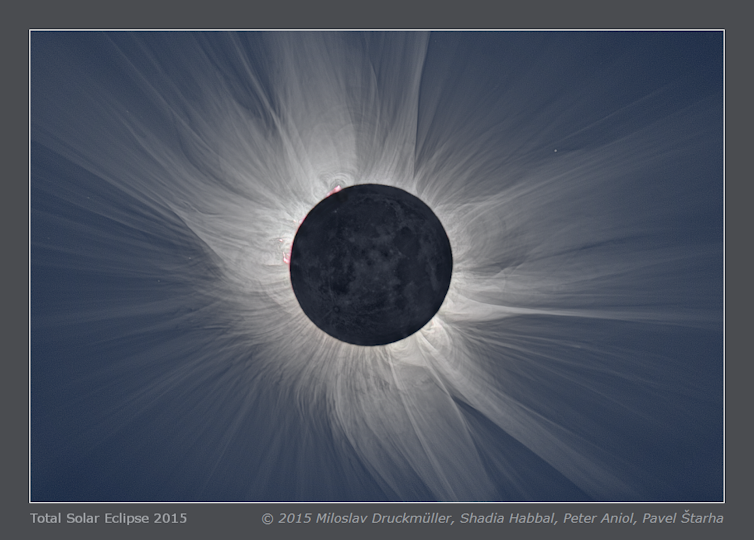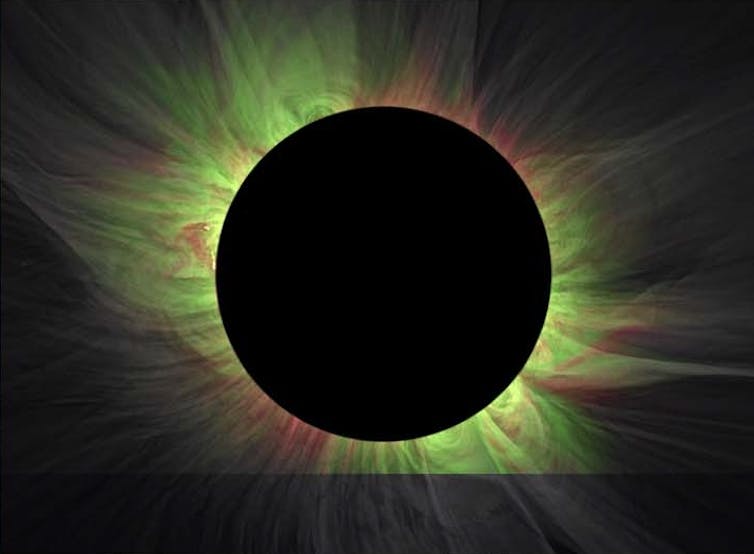Being within a narrow path across Mexico, the United States and eastern Canada on April 8 will give a rare chance to see the hottest thing any human ever sees: the corona surrounding the sun.
The word "corona" means "crown"—during the eclipse, it becomes visible, and streaming plasma leaving the sun appears in amazing patterns.
This outer atmosphere shines with a strange whitish light, and is safe to look at once the bright surface of the sun is fully obscured. However, it is not safe to look at partial phases of the eclipse without suitable eye protection such as an approved filter or a shadow box.
Humankind has been awed by this spectacle for a very long time without understanding it. Astronomers now know the sun's corona is heated to up to two million degrees Kelvin, numerically almost equivalent to Celsius for such high temperatures.
What astronomers haven't figured out yet is why the corona is so hot.
NASA scientists describe photographing the sun's corona during the 2015 eclipse.
Heat and density
The surface of the sun has a temperature of only about 5,800 kelvins (5,500 C). The reason that we can safely look at the corona but must avoid looking at the surface has to do with density: the corona is very thin, and most of the light we see is reflected sunlight from the surface.
The sun's surface has enough density that, at its temperature, it emits about 65 megawatts for each square meter. Even diluted by distance from the sun of 150 million kilometres, this is enough to cause immediate eye damage.
Since the corona is such thin gas, despite its high temperature, it does not emit nor reflect much light. For this reason, we can see it only when the body of the sun is completely blocked by the moon. Otherwise the scattered light in our atmosphere completely overwhelms it.
The mystery of the corona's heat puzzled 19th-century astronomers. At the time, new instruments had been developed to study the composition of celestial bodies.
In 1704, Sir Isaac Newton had discovered that "white" light could be split into colors, a result published in Opticks. Unfortunately, his basic views about light were wrong and likely set back the development of optical science 100 years!
Only in the early 1800s were instruments developed, largely setting the stage for the immensely profitable German optical industry. This allowed scientists to find out what materials were made of by the light they emitted when heated.
A staple of such studies was the Bunsen burner, originally developed not to have a colour like other flames do.

(M. Druckmüller, S. Habbal, P. Aniol, P. Štarha)
Photography and astrophysics
The parallel development of photography also helped astronomy to turn into the science of astrophysics, and the sun was an ideal first target for early instruments due to being very bright.
During the solar eclipse of 1868, emissions like the bright red known to be from hydrogen were observed. But when this light was broken down with a spectroscope, it also showed a yellow light that had never been observed on Earth.
This was determined to be a new element, named for its association with the sun (Greek helios). Only in 1895 was helium found on Earth, and in the strangest of places: radioactive ores.
Almost all helium now used on Earth comes from natural gas fields, where it is trapped as it comes up from uranium and other decaying radioactive ores. The helium in the sun later became strong evidence for the Big Bang, in which the first nuclei, which were hydrogen, quickly underwent nuclear fusion to produce helium, but its discovery in the sun set the stage for expecting new elements there.
A new mystery
Once spectroscopy developed further in the late 19th century, indeed another mystery arose. Many elements had been discovered on Earth and put in systematic order by Russian chemist Dmitri Mendeleev as the "periodic table."
Surprisingly, many elements were also detected in solar spectra, usually when they absorbed specific wavelengths from the pure light coming from deep layers in the sun, leaving absorption lines. Although the sun is made mostly of hydrogen and helium, these are not prominent in its spectrum.
However, in the corona, completely unknown lines were found. Following the lead of helium, it was felt that the sun must contain an element never observed on Earth, promptly dubbed coronium. Only in the 1940s was it realized that the emissions actually came from familiar elements, including iron. These were not initially recognized due to being highly stripped of the normal number of electrons going around their nuclei (normally 26 in iron), indicating extreme temperatures that rip atoms apart.
Even stranger, the further out one observed from the sun, the hotter the corona became.

(SOURCE), CC BY
Solar winds and weather
In the late 1950s, the physicist Eugene Parker found that such high temperatures for the solar corona meant that it could not be static: it had to be blowing off into space. This prediction was verified by spacecraft measurements in 1959.
Since then, we have known that there is a solar wind, and that the magnetic field shown by coronal structures is carried off into space with it. The solar wind can bring energy to Earth, which penetrates near us when the magnetic field is opposed to that of our planet, bringing auroras and potentially hazardous "space weather."
NASA's Parker Solar Probe is now nearing the inner regions of the corona, still trying to determine the exact origins of the solar wind. Parker, who passed away in 2022, saw initial results from this spacecraft trying to find exactly how the outrageously hot corona propels the solar wind.
Meanwhile, April 8 is a rare opportunity to safely view the sun's glorious super-heated corona. ![]()
This article is republished from The Conversation under a Creative Commons license. Read the original article.